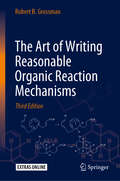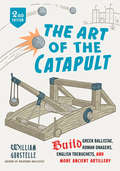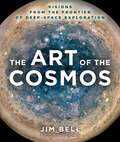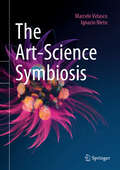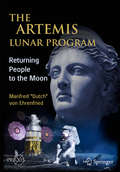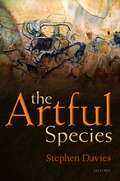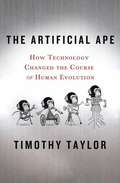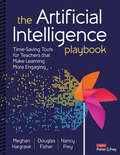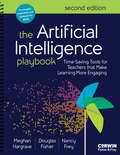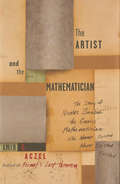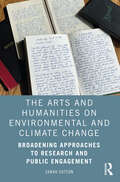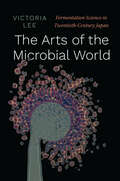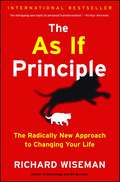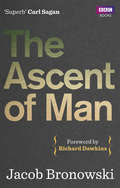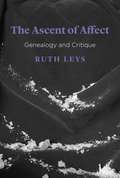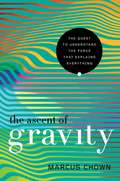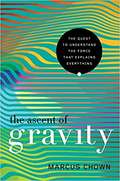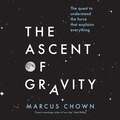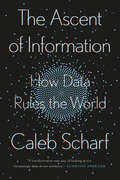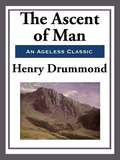- Table View
- List View
The Art of War: Timeless Wisdom Distilled (Concise Classics)
by Sun TzuTHE MOST IMPACTFUL LESSONS OF SUN TZU PAIRED WITH THOUGHTFUL ANALYSIS AND MODERN APPLICATIONS IN AN ELEGANT AND ACCESSIBLE FORMATSun Tzu's The Art of War is a timeless masterpiece of strategy and leadership, celebrated for its profound insights into preparation, adaptability, and the importance of understanding both oneself and others. Originally conceived as a military manual, its lessons have transcended their origins to become essential reading for anyone navigating challenges in life, business, and creativity. Its brilliance lies in its subtle, universal wisdom, which remains strikingly relevant after more than two millennia.This edition will help you master the art of strategy and apply it to your own life. With engaging double-page spreads, it curates Sun Tzu's key strategies, pairing them with modern analysis and practical applications you can use immediately. Calibrated to deliver timeless, perspective-shifting insights rapidly and directly, it reveals the strategies that have shaped leaders across the ages and continue to inspire today.WHY NOT EXPLORE FURTHER CONCISE CLASSICS FROM THIS SERIES?Also available: Think and Grow Rich, Meditations, The Prophet, and Autobiography of a Yogi.
The Art of War: Timeless Wisdom Distilled (Concise Classics)
by Sun TzuTHE MOST IMPACTFUL LESSONS OF SUN TZU PAIRED WITH THOUGHTFUL ANALYSIS AND MODERN APPLICATIONS IN AN ELEGANT AND ACCESSIBLE FORMATSun Tzu's The Art of War is a timeless masterpiece of strategy and leadership, celebrated for its profound insights into preparation, adaptability, and the importance of understanding both oneself and others. Originally conceived as a military manual, its lessons have transcended their origins to become essential reading for anyone navigating challenges in life, business, and creativity. Its brilliance lies in its subtle, universal wisdom, which remains strikingly relevant after more than two millennia.This edition will help you master the art of strategy and apply it to your own life. With engaging double-page spreads, it curates Sun Tzu's key strategies, pairing them with modern analysis and practical applications you can use immediately. Calibrated to deliver timeless, perspective-shifting insights rapidly and directly, it reveals the strategies that have shaped leaders across the ages and continue to inspire today.WHY NOT EXPLORE FURTHER CONCISE CLASSICS FROM THIS SERIES?Also available: Think and Grow Rich, Meditations, The Prophet, and Autobiography of a Yogi.
The Art of Writing Reasonable Organic Reaction Mechanisms
by Robert B. GrossmanIntended for students of intermediate organic chemistry, this text shows how to write a reasonable mechanism for an organic chemical transformation. The discussion is organized by types of mechanisms and the conditions under which the reaction is executed, rather than by the overall reaction as is the case in most textbooks. Each chapter discusses common mechanistic pathways and suggests practical tips for drawing them. Worked problems are included in the discussion of each mechanism, and "common error alerts" are scattered throughout the text to warn readers about pitfalls and misconceptions that bedevil students. Each chapter is capped by a large problem set.
The Art of the Catapult: Build Greek Ballistae, Roman Onagers, English Trebuchets, And More Ancient Artillery
by William GurstelleCalling all pumpkin chuckers, wannabe marauders, and tinkerers of all ages! Flinging things and playing at defending your own castle has never been more fun. Whether playing at defending their own castle or simply chucking pumpkins over a fence, wannabe marauders and tinkerers will become fast acquainted with Ludgar the War Wolf, Ill Neighbor, Cabulus, and the Wild Donkey—ancient artillery devices known commonly as catapults. Updated and improved instructions and diagrams illustrate how to build 10 authentic working model catapults, including an early Greek ballista, a Roman onager, and the apex of catapult technology, the English trebuchet. Additional projects include learning how to lash and make rope and how to construct and use a hand sling and a staff sling. Building these simple yet sophisticated machines introduces fundamentals of math and physics using levers, force, torsion, tension, and traction. The colorful history of siege warfare is explored through the stories of Alexander the Great and his battle of Tyre; Saladin, Richard the Lionheart, and the Third Crusade; pirate-turned-soldier Jon Crabbe and his ship-mounted catapults; and Edward I of England and his battle against the Scots at Stirling Castle. For the legions of Tolkien fans, budding backyard warriors, and engineering wizards, this book is a must-have.
The Art of the Cosmos: Visions from the Frontier of Deep Space Exploration
by Jim BellHundreds of deep space missions since the 1960s have captured stunning photographs of the cosmos. Many of these scientific images can also be classified as art. This book highlights more than 100 examples, revealing the splendor of our universe. This book is a gallery of human accomplishment that celebrates the scientists and engineers who push civilization—including the ways that we produce and experience art—beyond the physical limits of our planet. The photographs, selected by Dr. Jim Bell, represent some of the finest examples of the art of deep space exploration, most of them involving high-tech robotic emissaries. The images are loosely organized by distance from the Earth, so that readers will slowly travel on a journey farther and farther away from home, ultimately voyaging out to vistas of the farthest-known places in the universe.
The Art-Science Symbiosis
by Marcelo Velasco Ignacio NietoThis book delves into the long-standing human aspiration to combine art and science. In six chapters, The Art-Science Symbiosis outlines new approaches to understand current scientific practice in general and art-science in particular, showcasing how contemporary art can provide a unique perspective on the meaning and potential of collaboration. With more than a hundred full colour images, The Art-Science Symbiosis serves as a resource for researchers interested in the art-science integration, as well as a general reference for interdisciplinary and transdisciplinary work.In the book, twenty-two works have been selected based on their inherent merits and for the emergent knowledge that their art-science integration produces. These works have sparked novel questions, ideas and curiosity amongst scientists and artists alike which, we hope, will promote further dialogue not only amongst them but with the general public, inspiring a process that may leadto diverse, complex, and promising results with real-world consequences we have as yet to uncover.The Key messages of the book are:● Contemporary art is a powerful space of dialogue between science and the public● Interdisciplinary work based on symmetrical collaboration promotes groundbreaking results● Artistic inquiry can lead to new understanding of scientific exploration● Art-science practice could be started using a simple methodology
The Artemis Lunar Program: Returning People to the Moon (Springer Praxis Books)
by Manfred “Dutch” von EhrenfriedThis book describes the future of the Artemis Lunar Program from the years 2017 to about 2030. Despite the uncertainty of the times and the present state of space exploration, it is likely that what is presented in this book will actually happen, to one degree or another. As history has taught us, predictions are often difficult, but one can see enough into the future to be somewhat accurate. As the Bible says, “Wesee thru the glass, but darkly.”All of the elements of the proposed program are described from several perspectives: NASA’s, the commercial space industry and our International partners. Also included are descriptions of the many vehicles, habitats, landers, payloads and experiments. The book tells the story of the buildup of a very small space station in a strange new lunar orbit and the descent of payloads and humans, including the first women and next man, to the lunar surface with the intent to evolve a sustained presence over time.
The Artful Species: Aesthetics, Art, And Evolution
by Stephen DaviesThe Artful Species explores the idea that our aesthetic responses and art behaviors are connected to our evolved human nature. Our humanoid forerunners displayed aesthetic sensibilities hundreds of thousands of years ago and the art standing of prehistoric cave paintings is virtually uncontested. In Part One, Stephen Davies analyses the key concepts of the aesthetic, art, and evolution, and explores how they might be related. He considers a range of issues, including whether animals have aesthetic tastes and whether art is not only universal but cross-culturally comprehensible. Part Two examines the many aesthetic interests humans take in animals and how these reflect our biological interests, and the idea that our environmental and landscape preferences are rooted in the experiences of our distant ancestors. In considering the controversial subject of human beauty, evolutionary psychologists have traditionally focused on female physical attractiveness in the context of mate selection, but Davies presents a broader view which decouples human beauty from mate choice and explains why it goes more with social performance and self-presentation. Part Three asks if the arts, together or singly, are biological adaptations, incidental byproducts of nonart adaptations, or so removed from biology that they rate as purely cultural technologies. Davies does not conclusively support any one of the many positions considered here, but argues that there are grounds, nevertheless, for seeing art as part of human nature. Art serves as a powerful and complex signal of human fitness, and so cannot be incidental to biology. Indeed, aesthetic responses and art behaviors are the touchstones of our humanity.
The Artificial Ape: How Technology Changed the Course of Human Evolution
by Timothy TaylorWhile Darwin's theory explains our common descent, scientists have grappled with the reasons why human evolution defies the principles of natural selection and why, although we dominate the planet, we have become the weakest ape. In this fascinating narrative, leading archaeologist Timothy Taylor proposes that it was our early adoption of tools, objects, and, now, technology that changed us, demonstrating how: baby slings made out of animal fur freed up our arms up to use tools; clothes kept us warm, reducing our need for body hair; shelter protected us from the elements and led our bodies to become slighter and physically weaker. Drawing on the latest fossil evidence, Taylor shows how humans made choices that assumed greater control over their own evolution.
The Artificial Intelligence Playbook: Time-Saving Tools for Teachers that Make Learning More Engaging
by Douglas Fisher Nancy Frey Meghan HargraveTime Saving AI Tools that Make Learning More Engaging Busy educators need tools that support their planning and provide them with more time with students. While Artificial Intelligence (AI) has emerged as a promising solution, it can only help if we’re willing to learn how to use it in ways that improve upon what we already do well. The Artificial Intelligence Playbook: Time Saving Tools that Make Learning More Engaging is here to empower teachers to explore AI’s potential and discover practical ways to implement it to enhance their planning and instruction. Two chapters and 6 "Educator Functions" guide teachers step-by-step through how to purposely use AI to: Compose Writing Prompts and Avoid Plagiarism Manage Content Foster Student Engagement Meet Students’ Instructional Needs Assess Student Learning Continue Lifelong Learning Though AI has the potential to reduce workload for educators, it will never replace teachers. Your connection with students is irreplaceable—and greatly impacts their learning. Consider AI a valuable tool that provides you with more time to build and sustain those vital relationships with students and that can assist them in learning at the very same time.
The Artificial Intelligence Playbook: Time-Saving Tools for Teachers that Make Learning More Engaging
by Douglas Fisher Nancy Frey Meghan HargraveTime Saving AI Tools that Make Learning More Engaging Busy educators need tools that support their planning and provide them with more time with students. While Artificial Intelligence (AI) has emerged as a promising solution, it can only help if we’re willing to learn how to use it in ways that improve upon what we already do well. The Artificial Intelligence Playbook: Time Saving Tools that Make Learning More Engaging is here to empower teachers to explore AI’s potential and discover practical ways to implement it to enhance their planning and instruction. Two chapters and 6 "Educator Functions" guide teachers step-by-step through how to purposely use AI to: Compose Writing Prompts and Avoid Plagiarism Manage Content Foster Student Engagement Meet Students’ Instructional Needs Assess Student Learning Continue Lifelong Learning Though AI has the potential to reduce workload for educators, it will never replace teachers. Your connection with students is irreplaceable—and greatly impacts their learning. Consider AI a valuable tool that provides you with more time to build and sustain those vital relationships with students and that can assist them in learning at the very same time.
The Artificial Intelligence Playbook: Time-Saving Tools for Teachers that Make Learning More Engaging
by Douglas Fisher Nancy Frey Meghan HargraveThe Latest Time Saving AI Tools that Make Learning More Engaging Busy educators need tools that support their planning and provide them with more time with students. While artificial intelligence (AI) has emerged as a promising solution, it can only help if we’re willing to continuously learn how to use it in ways that improve upon what we already do well. The Artificial Intelligence Playbook: Time-Saving Tools for Teachers that Make Learning More Engaging, Second Edition, is a thoroughly updated, expanded new edition that reflects the transformative changes that have emerged since the first publication, offering updated strategies, insights, research, and examples that address the latest developments in AI technology. Learn how to purposefully use AI with: Best practices for composing effective prompts for optimal output and incorporating images, PDFs, or other documents with those prompts An expanded look at the responsible use of generative AI, addressing plagiarism, citations, and other common concerns New strategies and research supporting AI literacy instruction to prepare students for an AI-powered future More classroom examples demonstrating AI use cases for instructional best practices across various grade levels Practical ways to implement AI to enhance teaching functions from planning, instruction, assessment, student engagement, and more. Though AI has the potential to reduce workload for educators, it will never replace teachers. Your connection with students is irreplaceable—and greatly impacts their learning. With The Artificial Intelligence Playbook, Second Edition, in hand, educators will find even more time-saving tools to help build and sustain those vital relationships with students all while enhancing learning and engagement in the classroom.
The Artificial Intelligence Playbook: Time-Saving Tools for Teachers that Make Learning More Engaging
by Douglas Fisher Nancy Frey Meghan HargraveThe Latest Time Saving AI Tools that Make Learning More Engaging Busy educators need tools that support their planning and provide them with more time with students. While artificial intelligence (AI) has emerged as a promising solution, it can only help if we’re willing to continuously learn how to use it in ways that improve upon what we already do well. The Artificial Intelligence Playbook: Time-Saving Tools for Teachers that Make Learning More Engaging, Second Edition, is a thoroughly updated, expanded new edition that reflects the transformative changes that have emerged since the first publication, offering updated strategies, insights, research, and examples that address the latest developments in AI technology. Learn how to purposefully use AI with: Best practices for composing effective prompts for optimal output and incorporating images, PDFs, or other documents with those prompts An expanded look at the responsible use of generative AI, addressing plagiarism, citations, and other common concerns New strategies and research supporting AI literacy instruction to prepare students for an AI-powered future More classroom examples demonstrating AI use cases for instructional best practices across various grade levels Practical ways to implement AI to enhance teaching functions from planning, instruction, assessment, student engagement, and more. Though AI has the potential to reduce workload for educators, it will never replace teachers. Your connection with students is irreplaceable—and greatly impacts their learning. With The Artificial Intelligence Playbook, Second Edition, in hand, educators will find even more time-saving tools to help build and sustain those vital relationships with students all while enhancing learning and engagement in the classroom.
The Artist and the Mathematician
by Amir AczelNicolas Bourbaki, whose mathematical publications began to appear in the late 1930s and continued to be published through most of the twentieth century, was a direct product as well as a major force behind an important revolution that took place in the early decades of the twentieth century that completely changed Western culture. Pure mathematics, the area of Bourbaki's work, seems on the surface to be an abstract field of human study with no direct connection with the real world. In reality, however, it is closely intertwined with the general culture that surrounds it. Major developments in mathematics have often followed important trends in popular culture; developments in mathematics have acted as harbingers of change in the surrounding human culture. The seeds of change, the beginnings of the revolution that swept the Western world in the early decades of the twentieth century -- both in mathematics and in other areas -- were sown late in the previous century. This is the story both of Bourbaki and the world that created him in that time. It is the story of an elaborate intellectual joke -- because Bourbaki, one of the foremost mathematicians of his day -- never existed.
The Arts and Humanities on Environmental and Climate Change: Broadening Approaches to Research and Public Engagement
by Sarah SuttonThe Arts and Humanities on Environmental and Climate Change examines how cultural institutions and their collections can support a goal shared with the scientific community: creating a climate-literate public that engages with environmental issues and climate change in an informed way. When researchers, curators, and educators use the arts and humanities to frame discussions about environmental and climate change, they can engage a far wider public in learning, conversation, and action than science can alone. Demonstrating that archival and object-based resources can act as vital evidence for change, Sutton shows how the historical record, paired with contemporary reality, can create more personal connections to what many consider a remote experience: the changing climate. Providing valuable examples of museum collections used in discussions of environmental and climate change, the book shares how historic images and landscape paintings demonstrate change over time; and how documentary evidence in the form of archaeological reports, ships logs, Henry David Thoreau’s journals, and local reports of pond hockey conditions are being used to render climate data more accessible. Images, personal records, and professional documents have critical roles as boundary objects and proxy data. These climate resources, Sutton argues, are valuable because they make climate change personal and attract a public less interested in a scientific approach. This approach is underused by museums and their research allies for public engagement and for building institutional relevancy. The Arts and Humanities on Environmental and Climate Change will be most interesting to readers looking for ways to broaden engagement with environmental and climate issues. The ideas shared here should also act as inspiration for a broad spectrum of practitioners, particularly those writing, designing, and curating public engagement materials in museums, for wider research, and for the media.
The Arts of the Microbial World: Fermentation Science in Twentieth-Century Japan (Synthesis)
by Victoria LeeThe first in-depth study of Japanese fermentation science in the twentieth century.The Arts of the Microbial World explores the significance of fermentation phenomena, both as life processes and as technologies, in Japanese scientific culture. Victoria Lee’s careful study documents how Japanese scientists and skilled workers sought to use the microbe’s natural processes to create new products, from soy-sauce mold starters to MSG, vitamins to statins. In traditional brewing houses as well as in the food, fine chemical, and pharmaceutical industries across Japan, they showcased their ability to deal with the enormous sensitivity and variety of the microbial world. Charting developments in fermentation science from the turn of the twentieth century, when Japan was an industrializing country on the periphery of the world economy, to 1980 when it had emerged as a global technological and economic power, Lee highlights the role of indigenous techniques in modern science as it took shape in Japan. In doing so, she reveals how knowledge of microbes lay at the heart of some of Japan’s most prominent technological breakthroughs in the global economy. At a moment when twenty-first-century developments in the fields of antibiotic resistance, the microbiome, and green chemistry suggest that the traditional eradication-based approach to the microbial world is unsustainable, twentieth-century Japanese microbiology provides a new, broader vantage for understanding and managing microbial interactions with society.
The As If Principle
by Richard WisemanVictorian philosopher William James had a theory about emotion and behavior: It isn't that our feelings guide our actions (feel happy and you will laugh). On the contrary, it is our actions that guide our emotions (laugh and you will feel happy). This led James to a remarkable conclusion: "If you want a quality, act as if you already have it." Roused by James's astonishing discovery, renowned psychologist and bestselling author Richard Wiseman confirms James's principle and shows how the self-help genre has for too long put the cart before the horse in trying to help us take control of our lives. Bringing to the table a dazzling array of firsthand experiments, surprising histories, and psychological case studies, Wiseman illustrates in brilliant detail how we can apply this principle in our daily lives: --Smile to become measurably happier --Wash your hands to drive away guilt --Clench your fist to increase your willpower --Eat with your non-dominant hand to lose weight --Nod while speaking to become more persuasive --Act like a newlywed to rekindle your marriage Lively, engaging, and truly mind-changing, The As If Principle is that rare gem that offers real, workable solutions for your day-to-day goals while helping you to instantly take control of your emotions. Whether it's quitting a bad habit, persevering through a difficult task, or achieving your dream self, The As If Principle can help. Don't just think about changing your life. Do it.
The Ascent Of Man
by Jacob BronowskiDr Jacob Bronowksi's The Ascent of Man traces the development of human society through our understanding of science.First published in 1973 to accompany the groundbreaking BBC television series, it is considered one of the first works of 'popular science', illuminating the historical and social context of scientific development for a generation of readers. In his highly accessible style, Dr Bronowski discusses human invention from the flint tool to geometry, agriculture to genetics, and from alchemy to the theory of relativity, showing how they all are expressions of our ability to understand and control nature.In this new paperback edition, The Ascent of Man inspires, influences and informs as profoundly as ever.
The Ascent of Affect: Genealogy and Critique
by Ruth LeysIn recent years, emotions have become a major, vibrant topic of research not merely in the biological and psychological sciences but throughout a wide swath of the humanities and social sciences as well. Yet, surprisingly, there is still no consensus on their basic nature or workings. Ruth Leys’s brilliant, much anticipated history, therefore, is a story of controversy and disagreement. The Ascent of Affect focuses on the post–World War II period, when interest in emotions as an object of study began to revive. Leys analyzes the ongoing debate over how to understand emotions, paying particular attention to the continual conflict between camps that argue for the intentionality or meaning of emotions but have trouble explaining their presence in non-human animals and those that argue for the universality of emotions but struggle when the question turns to meaning. Addressing the work of key figures from across the spectrum, considering the potentially misleading appeal of neuroscience for those working in the humanities, and bringing her story fully up to date by taking in the latest debates, Leys presents here the most thorough analysis available of how we have tried to think about how we feel.
The Ascent of Gravity: The Quest To Understand The Force That Explains Everything
by Marcus ChownWhy the force that keeps our feet on the ground holds the key to understanding the nature of time and the origin of the universe. Gravity is the weakest force in the everyday world yet it is the strongest force in the universe. It was the first force to be recognized and described yet it is the least understood. It is a "force" that keeps your feet on the ground yet no such force actually exists. Gravity, to steal the words of Winston Churchill, is "a riddle, wrapped in a mystery, inside an enigma." And penetrating that enigma promises to answer the biggest questions in science: what is space? What is time? What is the universe? And where did it all come from? Award-winning writer Marcus Chown takes us on an unforgettable journey from the recognition of the "force" of gravity in 1666 to the discovery of gravitational waves in 2015. And, as we stand on the brink of a seismic revolution in our worldview, he brings us up to speed on the greatest challenge ever to confront physics.
The Ascent of Gravity: The Quest to Understand the Force that Explains Everything
by Marcus ChownThe Sunday Times Science Book of the Year 2017'Does Einstein proud . . . Eminently readable' Guardian'No one has covered the topic with such a light touch and joie de vivre . . . a delight' Brian CleggGravity was the first force to be recognised and described yet it is still the least understood. If we can unlock its secrets, the force that keeps our feet on the ground holds the key to understanding the biggest questions in science: what is space? What is time? What is the universe? And where did it all come from?Award-winning writer Marcus Chown takes us on an unforgettable journey from the recognition of the 'force' of gravity in 1666 to the discovery of gravitational waves in the twenty-first century. And, as we stand on the brink of a seismic revolution in our worldview, he brings us up to speed on the greatest challenge ever to confront physics.
The Ascent of Gravity: The Quest to Understand the Force that Explains Everything
by Marcus ChownThe Sunday Times Science Book of the Year 2017'Does Einstein proud . . . Eminently readable' Guardian'No one has covered the topic with such a light touch and joie de vivre . . . a delight' Brian CleggGravity was the first force to be recognised and described yet it is still the least understood. If we can unlock its secrets, the force that keeps our feet on the ground holds the key to understanding the biggest questions in science: what is space? What is time? What is the universe? And where did it all come from?Award-winning writer Marcus Chown takes us on an unforgettable journey from the recognition of the 'force' of gravity in 1666 to the discovery of gravitational waves in the twenty-first century. And, as we stand on the brink of a seismic revolution in our worldview, he brings us up to speed on the greatest challenge ever to confront physics.
The Ascent of Gravity: The Quest to Understand the Force that Explains Everything
by Marcus ChownGravity is the weakest force in the everyday world yet it is the strongest force in the universe. It was the first force to be recognised and described yet it is the least understood. It is a 'force' that keeps your feet on the ground yet no such force actually exists.Gravity, to steal the words of Winston Churchill, is 'a riddle, wrapped in a mystery, inside an enigma'. And penetrating that enigma promises to answer the biggest questions in science: what is space? What is time? What is the universe? And where did it all come from?Award-winning writer Marcus Chown takes us on an unforgettable journey from the recognition of the 'force' of gravity in 1666 to the discovery of gravitational waves in 2015. And, as we stand on the brink of a seismic revolution in our worldview, he brings us up to speed on the greatest challenge ever to confront physics.Read by Adjoa Andoh(p) 2017 Orion Publishing Group
The Ascent of Information: Books, Bits, Genes, Machines, and Life's Unending Algorithm
by Caleb ScharfYour information has a life of its own, and it&’s using you to get what it wants.One of the most peculiar and possibly unique features of humans is the vast amount of information we carry outside our biological selves. But in our rush to build the infrastructure for the 20 quintillion bits we create every day, we&’ve failed to ask exactly why we&’re expending ever-increasing amounts of energy, resources, and human effort to maintain all this data.Drawing on deep ideas and frontier thinking in evolutionary biology, computer science, information theory, and astrobiology, Caleb Scharf argues that information is, in a very real sense, alive. All the data we create—all of our emails, tweets, selfies, A.I.-generated text and funny cat videos—amounts to an aggregate lifeform. It has goals and needs. It can control our behavior and influence our well-being. And it&’s an organism that has evolved right alongside us.This symbiotic relationship with information offers a startling new lens for looking at the world. Data isn&’t just something we produce; it&’s the reason we exist. This powerful idea has the potential to upend the way we think about our technology, our role as humans, and the fundamental nature of life. The Ascent of Information offers a humbling vision of a universe built of and for information. Scharf explores how our relationship with data will affect our ongoing evolution as a species. Understanding this relationship will be crucial to preventing our data from becoming more of a burden than an asset, and to preserving the possibility of a human future.
The Ascent of Man
by Henry DrummondIn the Ascent of Man, Henry Drummond gives his take on Evolution. He sees evolution as divinely guided-- a position that made him no friends on either side of the debate. "'The greatest thing a human soul ever does in this world is to see something, and tell what it saw in a plain way.' In these pages an attempt is made to tell 'in a plain way' a few of the things which Science is now seeing with regard to the Ascent of Man. Whether these seeings are there at all is another matter. But, even if visions, every thinking mind, through whatever medium, should look at them. What Science has to say about himself is of transcendent interest to Man, and the practical bearings of this theme are coming to be more vital than any on the field of knowledge. The thread which binds the facts is, it is true, but a hypothesis. As the theory, nevertheless, with which at present all scientific work is being done, it is assumed in every page that follows."

